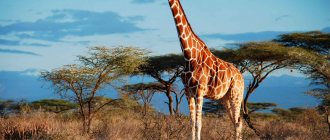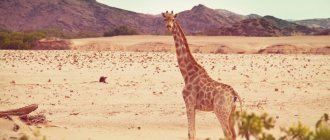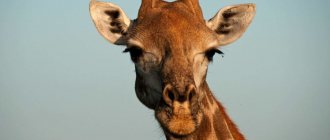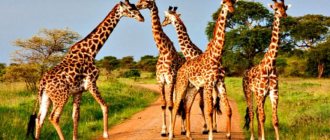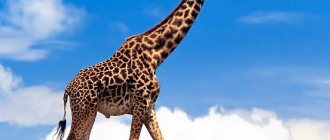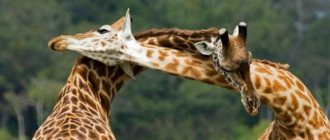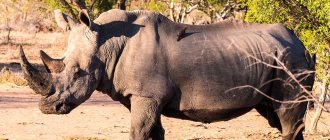- Wild animals
- >>
- Mammals
The giraffe is the tallest land animal.
Many have only seen them in pictures and cannot even imagine how amazing this animal is in real life. After all, it is not only its height that distinguishes it from other animals, but also many other features. The giraffe's head is unlike anyone else's: erect ears, blunt short horns, sometimes as many as five, black eyelashes around huge eyes, and the tongue is absolutely striking in its length, color and shape. Not every zoo has giraffes, and if there are, their enclosures usually go down to some depth, or occupy a couple of tiers, so that you can see the whole animal.
Its giraffes are only peaceful herbivores, but they also treat people absolutely calmly. But people, in turn, in ancient times actively hunted giraffes. Man has found many uses for everyday life from giraffe skin, its tendons and even its tail. But this killed a huge number of individuals, and now they approach giraffe hunting more wisely.
Blood pressure.
High blood pressure is required to keep blood from the heart moving up to the brain. When the animal's head is raised, this pressure at the level of the brain is the same as that of other large mammals. However, when lowering the head, the pressure in it could dangerously increase if the giraffe's brain were not protected by special vascular formations. There are two of them, and both are located at the base of the skull: here blood pressure is damped in a “wonderful network” (rete mirabile) of thin intertwining vessels, and valves in the veins allow blood to flow only in one direction (to the heart), preventing it from flowing back to the brain.
How many cervical vertebrae does a giraffe have?
Rhodesian
Despite the fact that the length of the animal’s neck can reach 2 m, it consists of only 7 vertebrae, like other mammals. The peculiarity of the giraffe's skeleton is that the cervical vertebrae are 25-30 cm long, and the special structure of the joints between their bodies ensures flexibility and mobility of the neck.
Horns.
Males and females have a pair of short, blunt horns covered with skin on the top of their heads. In males they are more massive and longer - up to 23 cm. Sometimes there is a third horn, on the forehead, approximately between the eyes; in males it is more common and more developed. Two bony outgrowths in the upper part of the back of the head, to which the neck muscles and ligaments are attached, can also grow greatly, resembling the shape of horns, which are called posterior, or occipital. In some individuals, usually old males, both three true horns and two posterior ones are well developed; they are called "five-horned" giraffes. Sometimes in old males other bony outgrowths are observed on the skull.
How did the giraffe develop a long neck?
West African
The first giraffes had a fairly large body and a relatively short neck. In the process of evolution, the cervical vertebrae lengthened and the animal acquired the appearance familiar to us. For a long time, it was believed that neck elongation was an adaptation to the environment: while foraging, animals were drawn to the upper branches of trees, which led to a change in body structure. At the end of the last century, a theory was put forward according to which the long neck used by males during fights is the result of sexual selection.
Food and water.
Giraffes are ruminants, like cows. They have a four-chambered stomach, and their jaws constantly chew cud—partially chewed food that is regurgitated from the first chamber of the stomach for secondary chewing. The giraffe's diet consists almost entirely of young shoots of trees and shrubs. Apparently, it prefers thorny acacias, but often also feeds on mimosas, wild apricots and some shrubs, and, if necessary, can also eat freshly grown grass.
Giraffes can survive without water for many weeks, possibly months.
Where does it live?
The savannahs of Africa are considered to be their natural habitat, outside of which this animal can only be found in zoos. Due to its low water consumption, it can sometimes be found in open forests and dry areas of the continent.
It is surprising that millions of years ago the ancestors of the giraffe could have existed not only on the hot continent, but also in Europe and Asia.
Social behavior and territoriality.
Typically, giraffes live alone (especially old males) or in small loosely formed groups of two to ten animals, less often in larger herds numbering up to 70 individuals. Herds can be mixed (males, females, young animals), bachelor (only young or only mature males) or consist of females and young animals. Giraffe vocalizations are typical of large herbivores, ranging from snorting and mooing to grunts and roars.
Not counting migration routes, the area of an individual giraffe's home range, i.e. The area in which it regularly grazes varies from approximately 23 to 163 km2 depending on the terrain.
Habitats
Where do giraffes live? Under natural conditions, giraffes live exclusively in Africa. In fact, they are one of the business cards of this
continent. As for Africa, you can meet giraffes both in its northern part, near the Sahara Desert, and in South Africa. Many giraffes live in national parks in East Africa, in Kenya, Tanzania, Rwanda, Uganda and other African countries.
Fights.
Giraffes are extremely peaceful and even timid animals, but males fight among themselves for leadership, and animals of both sexes engage in fights with predators if they cannot escape from them.
Within each population, the relationships of adult males are hierarchical. Hierarchy is maintained through fighting or threatening postures, such as lowering the neck to an almost horizontal position, as if the animal is preparing to butt an opponent. When fighting, two or more males stand side by side, facing the same or opposite directions, and swing their necks like giant hammers, trying to hit each other. The fight is often ritualized and does not cause harm to the participants, but sometimes, especially if several males are competing for a female ready to mate, it can end in a real knockout.
In a fight with a predator, the giraffe either slashes downwards with its front legs or kicks with its hind legs. The giraffe's hooves are very large - the diameter of the front ones reaches 23 cm. It is known that giraffes even killed attacking lions with a blow of their hooves.
Lifestyle
Recommended by topic
Fox Panda Lynx
The giraffe is endowed with excellent vision and hearing. This helps him notice the approach of the enemy and control the condition of his relatives. The viewing area of these mammals reaches 1 kilometer. These animals rest most of the day, but at the same time they carefully monitor their territory, reacting to any dangers.
Giraffes sleep little: the maximum they need to sleep is about four hours a day. However, on average they sleep only two hours, and sometimes the total amount of time spent sleeping is 20 minutes. At night, mammals sleep lying down, bending their neck so that their head rests on the lower part of their hind limbs. They take this position quite quickly, lowering themselves first to the chest and then to the stomach. This position resembles an arch in appearance and allows you to quickly mobilize in case of danger.
Giraffes sleep in this position
Giraffes get up early and prefer to have a hearty breakfast in the morning. At the same time, throughout the day they like to chew gum, resting in the shade of trees. At such moments, giraffes relax and are a little half asleep. However, their feelings are still very keen. Despite the half-closed eyes, the ears are constantly perked up and detect the slightest changes around.
Mammals are quite capable of dozing off during the day, but they do this in an upright position. The giraffe's strong neck muscles help the giraffe stay in this position, allowing it to doze while standing for several minutes.
Elena
Ask a Question
Question to the expert
Can giraffes touch the ground with their heads?
Despite having a long neck, the giraffe cannot fully reach the ground. To do this, he needs to perform very complex manipulations: spread his legs wide and bend his knees. This posture can cause injury.
During moments of physical activity, animals can gallop, although this happens quite rarely. They can endure such an active pace for no more than 3 minutes. Despite the short duration of the race, animals can accelerate to a speed of 45-50 km/h and jump over obstacles up to two meters high. Basically, giraffes move at a slow pace and prefer measured walking.
Giraffe walking
At short distances, giraffes can even outrun a racehorse.
Due to their heavy weight and thin legs, mammals can only walk on hard surfaces. For this reason, they avoid swampy areas. Rivers and other bodies of water become an insurmountable obstacle for them.
Enemies.
The only serious enemy of adult giraffes (apart from humans) is the lion. Most often, he attacks when the giraffe is lying or standing, awkwardly bent, drinking water or nibbling grass. Young giraffes are also preyed upon by other predators, such as leopards and hyenas.
For a long time, people killed giraffes for meat, tendons (for making bow strings, ropes and strings of musical instruments), tail tassels (for bracelets, fly swatters and threads) and skin (for making shields, drums, whips, sandals, etc. .). Uncontrolled hunting has become one of the main reasons for the decline in both the numbers and distribution of these animals.
Nutrition
Giraffes are artiodactyl herbivores. The basis of their diet is low-nutrient vegetation. Any greenery, flowers and leaves, located at a height of one and a half to more than two meters, are used. They have few competitors in this food niche.
Like any herbivores, giraffes themselves are food. An adult healthy animal is in virtually no danger. Babies and sick individuals have many enemies. These are large cats, hyenas, and wild dogs.
Usually the herd lifestyle and the tendency to protect their fellow tribesmen help out. One blow from this giant's hoof can disable any predator.
Reproduction.
Giraffes breed throughout the year, but tend to mate most intensively during the rainy season, such as March. Gestation lasts 15 months (457 days), and therefore the largest number of cubs are born during the dry season, i.e. approximately from May to August. Females typically give birth to one calf approximately every 20–23 months for approximately 15 years. During childbirth, the mother bends her hind legs; When a calf falls from a height to the ground, the umbilical cord breaks. Newborn, height approx. 2 m to the top of the head and weighing approx. 55 kg, is able to stand up within an hour, and often within 10 minutes after birth. He suckles milk up to 13 months, but begins to pluck leaves already at two weeks of age. Typically, the calf remains with its mother for another 2–5 months after the end of feeding. The mortality rate of young animals is high - up to 68% of calves die in the first year of life.
Female giraffes reach sexual maturity at 3.5 years of age and reach maximum size at 5 years of age; males mature by 4.5 years and are fully grown by seven. In nature, the average life expectancy is 6 years, and the maximum is approx. 26. The record for longevity in captivity is 36 years.
Interesting facts about giraffes
- Giraffes have a very long tongue. Adults are able to protrude it from their mouth almost 50 cm. In addition, it has a large number of muscles and is very mobile.
- The name of the animal comes from the Arabic “zarafah”, which means “fast walking”. Giraffes really move very quickly, covering considerable distances in search of food. If necessary, the giraffe's maximum speed can reach 60 km/h. The peculiarity of their running is that they do not lift their front and hind legs off the ground alternately, as almost all artiodactyls do, but simultaneously raise their front and hind limbs, located on one side of the body.
- The giraffe is a long-necked animal with fairly long legs. Due to the need to pump blood over long distances, the circulatory system of the artiodactyl has the following features: the heart weighs up to 13 kg; in the leg veins the lumen is only a fifth of their total thickness, the rest is muscle fibers that lift the blood upward; There are additional shut-off valves in the jugular veins.
- The tallest giraffe in the world has a height of 5 m 68 cm. The animal named Forest lives in one of the private zoos in Australia.
- In some sources you can find mention of dwarf giraffes. This is the name given to representatives of the second genus of the giraffe family - okapi. These small animals are more reminiscent of horses than their tall relatives. According to estimates, about 35-50 thousand individuals have survived in nature. Okapi are listed in the Red Book with the status of “endangered species”.
- From time to time, normally colored giraffes give birth to completely white babies. This coloration is associated with a genetic disorder - leucism. Currently, white giraffes have been spotted in Kenya. Unfortunately, two of the three rare animals were killed in 2022 by poachers. The third white male was fitted with an electronic beacon to receive information about his movements and protect him from poachers.
Classification and evolutionary history.
Giraffe and okapi ( Okapia johnstoni
) are the only modern representatives of the giraffe family (Giraffidae). It appeared in Central Asia in the early or middle Miocene, i.e. approximately 15 million years ago, and spread from there to Europe and Africa. The oldest remains of a modern giraffe were found in Israel and Africa and date back to the early Pleistocene, i.e. their age is approx. 1.5 million years.
The range of the modern giraffe has greatly decreased as a result of human hunting and anthropogenic changes in the environment. The species was found in northern Africa (in Morocco) 1,400 years ago, and in many areas in the west and south of the continent it was exterminated only in the last century. There are usually nine geographical races, or subspecies, distributed from Mali in the west to Somalia in the east and South Africa in the south.
Types of giraffes
Rothschild's giraffe
In the modern classification, nine subspecies are distinguished, differing in color and area of distribution on the continent:
- Nubian . One of the rarest subspecies, the approximate number of individuals is 250-300. The color consists of dark brown spots surrounded by almost white lines.
- Mesh . Lives in Kenya and Somalia. The spots are polygonal, pointed, separated by white lines. The population is estimated at 5,000 individuals.
- Angolan . The spots have jagged edges and elongated corners and cover the entire body, including the limbs. The most numerous subspecies: according to the latest data, the number of Angolan giraffes is about 20 thousand.
- Kordofansky . They live in Chad, Cameroon and Congo. Spots of various shapes with thick light brown lines between them. Cover the body, neck and upper limbs.
- Maasai . Lives in Tanzania. The spots are jagged and resemble irregularly shaped stars. The population numbers about 40 thousand individuals.
- Rothschild's giraffe . A rare breed of animal, about 600-700 individuals remain in nature. The spots have an irregular shape, are partially intersected by lines inside, and the middle is painted a darker shade than the edges.
- West African . Also known as the Nigerian subspecies. It has very light colored spots and lines. No more than 200-250 animals have survived in their natural habitat.
- Rhodesian . Lives in Zambia. The spots are star-shaped, partially crossed inside by lines.
- South African . The spots have rounded corners and are a rich brown-red color. The population is estimated at 10 thousand individuals.
Variety of subspecies
Currently, the giraffe family includes only 1 species, although initially there were 5. The remaining 4 are considered extinct. The classification is based on habitat and the nature of the patterns on the body.
It is customary to distinguish 9 subspecies:
- Nubian. The main area of residence is Ethiopia and Sudan, it has chestnut spots with a white “rim”; males are distinguished by a characteristic growth on the forehead.
- Mesh (Somali). Spots with sharp edges, edged with white, color red-brown.
- Ugandan. The brown spot is decorated with a wide white stripe.
- Kordofan. A feature of the subspecies is the presence of medium-sized spots, unevenly distributed over the surface of the body. Most of them are concentrated on the limbs, at the bottom of the hock joints.
- South African. Characterized by a golden hue of the skin and round dark spots. Body length can reach up to 6 meters, weight - over a ton.
- Angolan. Lives in Namibia and Botswana, has large brown spots with elongated corners.
- Thornycroft. Found in Zambia, its skin is decorated with a fine jagged pattern.
- West African. It is an endangered species; small populations now inhabit Chad.
- Massai. Its spots are shaped like a five-pointed star.
These are the main types of giraffes that inhabit the planet.
Freezing frogs
In the Arctic region there are frogs that, due to the cold climate and structural features of the body, are capable of temporarily freezing in the winter season, so to speak, hibernating. The amazing fact is that during this time their hearts stop beating. As soon as the temperature rises in the region and a thaw sets in, they wake up from the winter state and the functioning of their heart resumes. The mystery of nature hidden in the specific adaptation of freezing frogs is truly surprising and perplexing.
Cheetahs
These unique cats are considered the fastest animals in the world. They are found in African regions and surprise researchers with the fact that their heart can beat at a rate of up to 250 beats in a few seconds. The animal also has excellent external characteristics, such as a slender body, spotted fur and a small round head. Such an individual can reach a height of 70 to 90 cm.
Cheetahs can reach speeds of up to 112 km per hour. Their average speed is about 64 km per hour. This advantage helps them catch their prey with ease. All this happens thanks to the strength of their body. Yes, extraordinary features are also reflected in the blood flows transported by the body to the heart in an enhanced mode. Their long and flexible tail helps them change direction when they run. When a cheetah's heart rate reaches 170 beats per minute, its strength is depleted and it requires a temporary respite. These animals, especially females, are always fearless and cunning. Males are communicative and spend most of their time in small groups called coalitions.
Pygmy shrew
Another amazing animal is the tiny mammal, the dwarf shrew. Its main feature is a rapid heartbeat. It is the second largest mammal in the world.
As a rule, the smaller the animal, the faster its heartbeat. Dwarf shrews living in the regions of Alaska, Canada and the United States have a heart rate of more than 1000 per minute. Weighing just 4 grams, the tiny mammals have a heart that weighs 1.2% of their total body weight. These animals usually live no longer than one and a half years.
Found a violation? Report content
zebrafish
Would you like to have the ability to regenerate your heart? Sounds good, doesn't it? Zebrafish have this ability.
Their origins lie in South Asia, and their ability to regenerate has been a critical turning point for many scientists. The heart of a zebrafish has half as many chambers as a human's, but in terms of performance it is in no way inferior to it. Scientists claim that this type of fish has a unique ability to restore heart tissue. This happens over the course of several months. These fish are subjected to many experiments due to their amazing prerogative. Perhaps one day scientists will be able to find the reason for such a wonderful phenomenon.
